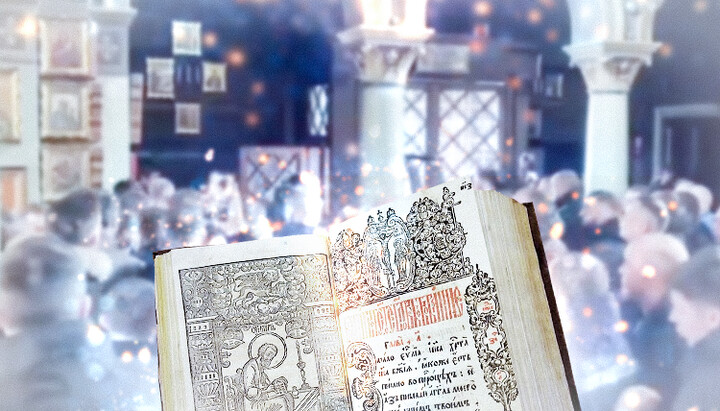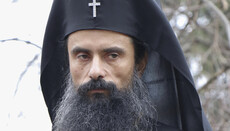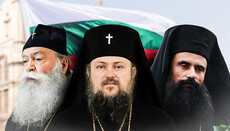How to counteract provocateurs: instructions from the Gospel

Temple seizures are happening today with provocateurs and other "role-players". What can be done against them?
On 2 April 2023, the Khmelnytskyi Cathedral was seized. During the service, which was attended by about 100 worshippers, a man in camouflage (Arthur Ananyev by name as it turned out later) attacked the protodeacon, tore his vestment and knocked the Gospel out of his hands. The archdeacon and the community reacted harshly – the provocateur was restrained and, as he resisted vigorously, slightly "crumpled up". A woman filmed the entire action on her phone, screaming into the camera that "a military man was being beaten".
The footage was immediately posted on social media. Khmelnytskyi MP Viktor Burlyk first published it on his Facebook with the comment: "A military man was beaten by Moscow priests" and then urged the crowd to come under the temple. Suddenly tables, papers and people appeared on the spot to organise a "vote to transfer to the OCU". Characteristically, the video of the "beating" starts directly from the "beating" itself, although the camera was clearly on earlier. What Ananyev was doing before this was not shown to us. Or rather, not exactly. The Telegram channel of S14 leader Yevhen Karas has some slow-motion footage of the protodeacon allegedly dropping the Gospel himself. The footage is meant to prove that Ananyev did not commit any unlawful acts and that the evil priests beat him up for nothing. And there are three points to note here:
- Karas' footage shows that the protodeacon's vestment has been torn, and it is unlikely that he did this himself.
- Again, we are not shown what happened before this.
- The very fact that an exclusive video taken in the Khmelnytskyi Cathedral by some woman (according to legend, a parishioner) suddenly appears on the page of one of the leaders of Kyiv radicals.
And here we must recall the instructions leaked online by Karas to his charges, where he told them how to provoke the clergy and believers in the Lavra. Their essence is simple. Radicals must group up in two or three, where one provokes people to aggression while others record this aggression on phones. The task is "to act as a catalyst in the conflict, to show that they behave as aggressors... So that everyone, including Europeans, will say that this is some kind of terrorist group, not monks”.
It didn't work in the Lavra because the faithful were warned. But in Khmelnytskyi the operation was carried out brilliantly. Not just there.
On the same day in the urban-type village of Irshansk, Zhytomyr region, at a meeting on the transfer of the cathedral to the OCU, UOC opponents staged an even more resounding provocation called "a Moscow priest hit a child on the head".
The blurred footage shows a boy with a flag being pushed at the praying priests by someone, after which some woman starts yelling, "You hit a child, you brute. Get out to Russia!" Needless to say, the outraged people voted "for" the transition. And the entire country received major nationwide hype. The story is all over the mass media and social networks. The police are investigating the case under Article 125, "Intentional minor bodily injury", of the Criminal Code.
It is easy to see that the same three-point scheme is used here as well:
- the provocation itself;
- videotaping;
- maximum publicity with a "correct" interpretation.
And there is no doubt that this technology, with different variations, will be used against the UOC in the future. What can we do? How can we counteract the provocateurs and make their provocations fail?
And here we need to remember that in Khmelnytskyi, the subdeacon and the believers reacted to the aggressive provocation fairly by secular standards but hardly fairly by evangelical standards.
Apparently, now is the time to put into practice the words of the Lord Jesus Christ: "But I tell you, do not resist an evil person. If anyone slaps you on the right cheek, turn to them the other cheek also...." (Matthew 5:39).
In interpreting this place of the Gospel, St. John Chrysostom puts it thus: "Truly, nothing so holds those who offend, as the meek patience of those who are offended. It not only keeps them from further attacks but also makes them repent of the previous ones, and makes them move away from the offended, surprised by their meekness, and finally, from the enemies and adversaries become not only their friends but even the closest people and slaves. On the contrary, vengeance produces quite the opposite effect. It causes shame to both of them, hardens them and inflames their anger even more, and the evil, extending further, often brings them to death. That is why the Saviour not only forbade the one who was struck but also commanded to satiate the desire of the one who struck so that it would not be noticeable that you suffered the first blow unwittingly. Indeed, by doing this you will hurt the shameless man more sensitively than if you had struck him with your hand, and you will make him meek out of the shameless man.”
Some may say, “If someone hits me, I will turn the other cheek, but there is an attack on the temple, on the holy place.” The Gospel also gives an answer to this question.
In the Garden of Gethsemane, when Judas came with the soldiers sent to capture Jesus, the apostle Peter drew his sword and began to defend himself. "Simon Peter, having the sword, drew it and struck the high priest's servant and cut off his right ear. The name of the servant was Malchus. Jesus commanded Peter, ‘Put your sword away! Shall I not drink the cup the Father has given me?’" (John 18:10,11). The Lord did not reproach the apostles for not defending Him, but lamented their scattering: “A time is coming and in fact has come when you will be scattered, each to your own home. You will leave me all alone. Yet I am not alone, for my Father is with me.” (John 16:32)
Hence, the main principle: we will protect the Church only if we do not scatter each to their own side, but remain faithful to Christ and His Church. If each believer remains faithful to his Church community, if each community remains as such, whether the temple has been taken from it or not, and if each priest does not yield to threats or persuasion and leave the Church, this will mean that the Church has not suffered any damage, that She continues to live and carry out Her saving mission on earth, connecting men with God.
However, in the current lawlessness, believers are interested in a practical question – how to protect their church?
We can experiment and try to literally fulfil Christ's commandment: "And if anyone wants to sue you and take your shirt, hand over your coat as well...." (Matthew 5:40). That is, give the temple, land, church property, etc. and see how the Lord will act next, how He will arrange our life and the life of the offenders.
We can try another commandment: "But I tell you, love your enemies, bless those who curse you, do good to those who hate you, and pray for those who spitefully use you and persecute you..." (Matthew 5:44). It is possible to make a list of church raiders by name, at least those who have been identified, for example, this Arthur Ananyev, and serve prayers for their health and salvation.
But the Gospel does not forbid the use of worldly, "practical" methods. How do we guard against provocation? What to do specifically?
I remember that some time ago there was a discussion among theologians about abolishing the prayer for the voiced at the Liturgy and the cry "Doors! Doors!" which called for the doors to be locked and no outsiders allowed in. People used to say at the time that it was an anachronism, as no one locked the doors any more. So:
- Lock the doors after the start of the service. This would be an additional stimulus for parishioners who allow themselves to be late.
- If financially possible, be sure to install a video surveillance system inside and outside the church. This will allow in case of provocations to show how things really happened.
- If there is financial aid, contract with a security firm to have their personnel present at least during the divine service.
- Identify "bodyguards" among the men who would be available to protect the clergy from attacks during the services, or to respond appropriately to other provocations by force.
- Appoint a few people who, in case of provocation, will film what is happening on the phone. Do not defend or obstruct the provocateurs but simply record the events silently.
- Never respond with violence to violence. If provocateurs tear down icons, throw the Gospel on the floor, push the priest, etc., you can simply stand between them and prevent them from continuing their unlawful actions with your presence.
- Legalize what has happened. Let the police take the side of the invaders, and let the local authorities take part in the case. It is still necessary to file applications, complaints, and lawsuits. Everything must be done properly: the circumstances, witnesses, and so on. If our courts will not help, we will have to go to European and international courts. A drop wears away the stone.
- Make a list of parishioners. In order for this list to have legal value, so that visiting raiders cannot pass themselves off as members of the community and vote for a transfer to the OCU, it is necessary in some way to legally formalize such a list. The legislation in this regard does not give an exhaustive answer to the question of how to do it, but we must try to formalize the list somehow: put the seal of the community as a legal entity, submit it to the local authorities as an application, and so on. In the future, perhaps our legislation will come to the point where membership in the religious community will be fixed, but already now it is necessary to formalize it somehow.
However, the main thing is, once again, to keep ourselves in the Church, not to leave this ark of salvation and believe that God will never leave us.





